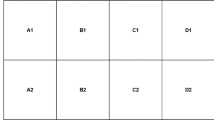Abstract
Dealing with a refurbished crime scene is a special challenge for forensic investigators. In such cases, a crime scene may not have only been cleaned in order to erase all traces but the walls of an indoor crime scene could also be painted over in order to mask traces of the crime. So far, very few publications have shown that painted-over traces of blood and seminal fluid can be detected using a forensic light source or infrared photography. To date, there have been no systematically executed research studies including guidelines on which settings to use depending on the color of the wall. Moreover, no comparative study has addressed the question of whether it is better to use infrared photography or a forensic light source to visualize painted-over bloodstains. The present study covers the aforementioned gaps and shows that painted-over bloodstains are most easily visualized by infrared photography, while traces of seminal fluid are most easily visualized at 440 nm in combination with a yellow filter—both independent of the color of the wall paint.





Similar content being viewed by others
References
Beauregard E, Martineau M (2014) No body, no crime? The role of forensic awareness in avoiding police detection in cases of sexual homicide. J Crim Just 42(2):213–220. https://doi.org/10.1016/j.jcrimjus.2013.06.007
Baskin DR, Sommers IB (2010) Crime-show-viewing habits and public attitudes toward forensic evidence: the “CSI effect” revisited. Justice Syst J 31:97–113
Durnal EW (2010) Crime scene investigation (as seen on TV). Forensic Sci Int 199(1-3):1–5. https://doi.org/10.1016/j.forsciint.2010.02.015
Bily C, Maldonado H (2006) The application of Luminol to bloodstains concealed by multiple layers of paint. J For Ident 56:896–905
Pettolina M, Rainey J, Sanchez R (2017) Using Bluestar forensic to detect latent bloodstains under coats of paint. J For Ident 67:341–353
Howard MC, Nessan M (2010) Detecting bloodstains under multiple layers of paint. J For Ident 60:682–717
Vandenberg N, van Oorschot RAH (2006) The use of Polilight in the detection of seminal fluid, saliva, and bloodstains and comparison with conventional chemical-based screening tests. J Forensic Sci 51(2):361–370. https://doi.org/10.1111/j.1556-4029.2006.00065.x
Adair TW (2006) Experimental detection of blood under painted surfaces. In: International Association of Bloodstain Pattern Analysts I.A.B.P.A. News 22(1):12–19
Ray B (1992) Use of alternative light sources for detection of body fluids. SWAFS J 14:30–33
Sterzik V, Bohnert M (2016) Reconstruction of crimes by infrared photography. Int J Legal Med 130(5):1379–1385. https://doi.org/10.1007/s00414-016-1343-2
Sterzik V, Bohnert M (2015) Bloodstain pattern analysis by infrared photography. In: 19th Nordic Congress on Forensic Medicine & 1st Annual Meeting of NAFT. S J F S, Stockholm. p 35
Farrar A, Porter G, Renshaw A (2012) Detection of latent bloodstains beneath painted surfaces using reflected infrared photography. J Forensic Sci 57:1190–1198
Walsh PS, Metzger DA, Higuchi R (1991) Chelex 100 as a medium for simple extraction of DNA for PCR-based typing from forensic material. BioTechniques 10(4):506–513
Garner DD, Cano KM, Peimer RS, Yeshion TE (1976) An evaluation of tetramethylbenzidine as a presumptive test for blood. J Forensic Sci 21(4):816–821
Kind SS (1965) The acid phosphatase-test. In: Curry AF (ed) Methods of forensic science, 3rd edn. Interscience Publisher, London, pp 267–288
de Almeida JP, Glesse N, Bonorino C (2011) Effect of presumptive tests reagents on human blood confirmatory tests and DNA analysis using real time polymerase chain reaction. Forensic Sci Int 206:58–61
Finnis J, Lewis J, Davidson A (2013) Comparison of methods for visualizing blood on dark surfaces. Sci Justice 53(2):178–186. https://doi.org/10.1016/j.scijus.2012.09.001
Middlestead C, Thornton JI (2010) Sensitivity of the Luminol test with blue denim. J Forensic Sci 55(5):1340–1342. https://doi.org/10.1111/j.1556-4029.2010.01427.x
Patel G, Hopwood A (2013) An evaluation of Luminol formulations and their effect on DNA profiling. Int J Legal Med 127(4):723–729. https://doi.org/10.1007/s00414-012-0800-9
Seashols SJ, Cross HD, Shrader DL, Rief A (2013) A comparison of chemical enhancements for the detection of latent blood. J Forensic Sci 58(1):130–133. https://doi.org/10.1111/j.1556-4029.2012.02259.x
Soderquist TJ, Chesniak OM, Witt MR, Paramo A, Keeling VA, Keleher JJ (2012) Evaluation of the catalytic decomposition of H2O2 through use of organo-metallic complexes—a potential link to the Luminol presumptive blood test. Forensic Sci Int 219(1-3):101–105. https://doi.org/10.1016/j.forsciint.2011.12.005
Li B, Beveridge P, WT O’H, Islam M (2014) The application of visible wavelength reflectance hyperspectral imaging for the detection and identification of blood stains. Sci Justice 54(6):432–438. https://doi.org/10.1016/j.scijus.2014.05.003
Raymond MA, Hall RL (1986) An interesting application of infra-red reflection photography to blood splash pattern interpretation. Forensic Sci Int 31(3):189–194. https://doi.org/10.1016/0379-0738(86)90187-8
Acknowledgements
We thank Corinne Moser for the technical assistance with the genetic analyses and presumptive tests.
Author information
Authors and Affiliations
Corresponding author
Ethics declarations
Conflict of interest
The authors declare that they have no conflict of interest.
Rights and permissions
About this article
Cite this article
Barrera, V., Haas, C., Meixner, E.A. et al. Detection of painted-over traces of blood and seminal fluid. Int J Legal Med 132, 1067–1074 (2018). https://doi.org/10.1007/s00414-018-1787-7
Received:
Accepted:
Published:
Issue Date:
DOI: https://doi.org/10.1007/s00414-018-1787-7




